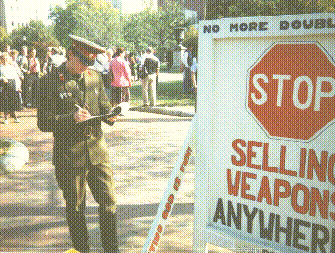Proposition One

THE NPT:
A HISTORY
But First:
Do Treaties Really Work?
The United States Constitution vests sole authority in the chief
executive to negotiate treaties. Within the existing framework,
the people are entirely removed from direct participation in the
formulation of international relationships.
Historically, treaties have failed to produce lasting peace or
meaningful disarmament, and they are not really enforceable (how
does one enforce a peace treaty except by going to war?).
Disarmament treaties so far have been highly publicized
smokescreens behind which leaders retired obsolete weapons
systems, but allowed new, more powerful ones to be developed.
The grand presidential "summits" calmed growing domestic
anti-nuclear unrest with pomp and promises that nevertheless
leave us still nearly extinct.
"Arms limitations" talks have been more about production levels
than actual, irrevocable reduction agreements. The governments
of the nuclear powers, not truly wishing to eliminate their most
awesome power, have sent negotiators to the table without any
real predilection toward zero nuclear weapons.
Treaties are negotiated and agreed upon by elected officials.
The mandate for a particular treaty may change when new officials
are elected. Constitutional law, however, remains intact through
each successive group of leaders, and, therefore, remains the law
those leaders must implement and "defend."
A CASE STUDY: VARIOUS PERSPECTIVES OF
THE NUCLEAR NON-PROLIFERATION TREATY (NPT)
Points to remember about the Treaty on Non-Proliferation of
Nuclear Weapons, signed July 1, 1968, enacted March 5, 1970, and
debated in New York the spring 1995:
* According to the Preamble, a purpose of the treaty was
to facilitate and guarantee access to peaceful applications of
nuclear technology and by-products, for all parties of the
treaty, whether nuclear or non-nuclear states, under the aegis of
the International Atomic Energy Agency.
* Additionally, quoting from the treaty's Preamble:
"Declaring their intention to achieve at the earliest possible
date the cessation of the nuclear arms race and to undertake
effective measures in the direction of nuclear disarmament,
"Urging the cooperation of all States in the attainment of
this objective,
"Recalling the determination expressed by the Parties to the
1963 Treaty banning nuclear weapon tests in the atmosphere, in
outer space and under water in its Preamble to seek to achieve
the discontinuance of all test explosions of nuclear weapons for
all time and to continue negotiations to this end,
"Desiring to further the easing of international tension and
the strengthening of trust between States in order to facilitate
the cessation of the manufacture of nuclear weapons, the
liquidation of all their existing stockpiles, and the elimination
from national arsenals of nuclear weapons and the means of their
delivery...."
* Of pivotal significance is Article VI:
"ARTICLE VI: Each of the parties to the Treaty undertakes to
pursue negotiations in good faith on effective measures relating
to cessation of the nuclear arms race at an early date and to
nuclear disarmament, and on a treaty on general and complete
disarmament under strict and effective international control...."
China, France, Russia, UK and USA, the only "recognized"
nuclear weapons powers in 1967 AND now, were the original
"nuclear" signatories. The Treaty provides for nonproliferation
conferences every five years.
By varying accounts, NPT currently has 167 signatory countries
(per current Greenpeace flier), 158, 165 or 172. A detailed
breakdown was obtained in 1993, from International Peace Bureau
(IPB):
"Present Parties to NPT:
"According to the United Nations' source, the number of the
Parties to NPT amounts to 158 states as of the end of 1993. The
... regions are as follows:
"Asia [and Middle East] 33 - Afghanistan, Bahrain,
Bangladesh, Bhutan, Brunei, Cambodia, China, Cyprus, Indonesia,
Iran, Iraq, Japan, Jordan, Korea (North), Korea (South), Kuwait,
Laos, Lebanon, Malaysia, Maldives, Mongolia, Myanmar, Nepal,
Philippines, Qatar, Saudi Arabia, Singapore, Sri Lanka, Syria,
Thailand, Turkey, VietNam, Yemen;
"Pacific, 10 - Australia, Fiji, Kiribati, Nauru, New Zealand,
Papua New Guinea, Solomon Islands, Tonga, Tuvalu, Western Samoa;
"Africa, 47 - Benin, Botswana, Burkina Faso, Burundi,
Cameroon, Cape Verde, Central Africa, Chad, Congo, Cote d'Ivoire,
Egypt, Equatorial Guinea, Ethiopia, Gabon, Gambia, Ghana, Guinea,
Guinea-Bisau, Kenya, Lesotho, Liberia, Libya, Madagascar, Malawi,
Mali, Mauritius, Morocco, Mozambique, Namibia, Niger, Nigeria,
Rwanda, Sao Tome and Principe, Senegal, Seychelles, Sierra Leone,
Somalia, South Africa, Sudan, Swaziland, Tanzania, Togo, Tunisia,
Uganda, Zaire, Zambia, Zimbabwe;
"Europe, 38 - Albania, Austria, Azerbaijan, Belarus, Belgium,
Bulgaria, Croatia, Czech, Denmark, Estonia, Finland, France,
Germany, Greece, Hungary, Iceland, Ireland, Italy, Latvia,
Liechtenstein, Lithuania, Luxembourg, Malta, Netherlands, Norway,
Poland, Portugal, Romania, Russia, San Marino, Slovakia,
Slovenia, Spain, Sweden, Switzerland, United Kingdom, Uzbekistan,
Vatican City;
"North America, 2 - Canada, United States;
"Central America, 20 - Antigua and Barbuda, Bahamas,
Barbados, Belize, Costa Rica, Haiti, Honduras, Jamaica, Mexico,
Nicaragua, Panama, Saint Kitts and Nevis, Saint Lucia, Saint
Vincent and the Grenadines, Trinidad and Tobago;
"South America, 8 - Bolivia, Colombia, Ecuador, Paraguay,
Peru, Suriname, Uruguay, Venezuela.
"As of 1993... 26 of the 184 member states of the United
Nations ha[d] not yet joined NPT. In Asia, India, Israel and
Pakistan, which have been suspected of the possession of nuclear
weapons, have not acceded to NPT. India allegedly conducted a
nuclear test in 1974. Democratic People's Republic of Korea
(North Korea) joined NPT in 1985, but declared its intention of
withdrawal from it in March 1993.... The Republic of South
Africa became a member state to NPT in 1991. According to the
statement of President deKlerk in March 1993, it had launched on
the development of nuclear weapons in 1974, and destroyed 6
nuclear weapons in 1990.
"The fifteen Republics of the former Soviet Union were a
single member to NPT as one federated state, but after the demise
of the Soviet Union in 1991 only seven of them (Azerbaijan,
Belarus, Estonia, Latvia, Lithuania, Russia and Uzbekistan) are
members. This poses a serious future problem since countries
like Ukraine still continue to possess nuclear weapons."
Text of NPT
Treaties Section 2
Chemical & Biological Weapons Ban Next Page
Nuclear Stockpiles; tests Previous Page
Proposition One Home Page

